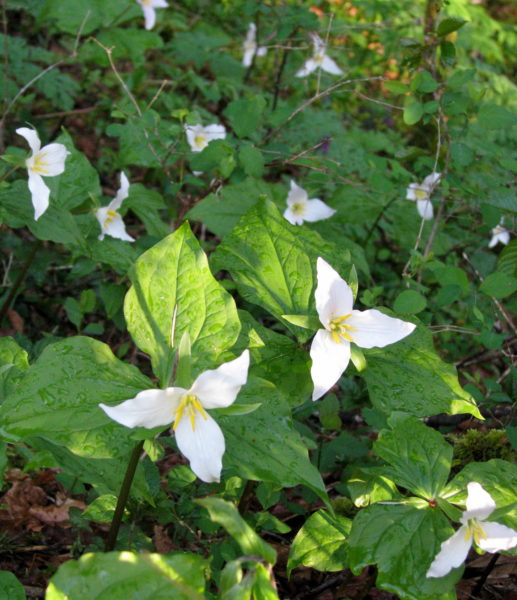The Richness in Connecting to Place

Everything is here to be happy on earth. We have snow and every day a new morning. We have trees and rain, hope and tears. We have humus and oxygen, animals and all the colours. We have distant lands and bicycles. We have sun and shadow. We are rich. Hundertwasser
The more I notice and respond to this place I live, the more my life becomes tied to it and the richer I feel. Talking to and interacting with new and old faces in the neighborhood, recognising plants and trees, knowing where I am on a map and where the Puntledge River is in relation to me are all starting points. Knowing some history gives depth to the experience. For example, near my neighborhood, the old penstock and concrete structures were built by the Canadian Colleries before WWI as they dammed the river to power the coal mines in Bevan upstream. Now this penstock, more commonly known as the pipeline, feeds the power generation that lights up my own home. This area is in the Comox Valley Regional District and is also the territory of the K’omoks First Nation. I find there is much to learn if I pay attention.
Weather or seasons, which are always in flux, are beginning to more distinctly echo the changes and revolutions of years in my own life. At the tail end of winter, the bright yellow tips of skunk cabbage point upwards out of the darkness, marking the start of a new season and this is when I start getting my own garden ready to plant. After the appearance of spring wildflowers such as, fawn lilies or trilliums, many other shrubs, trees and plants come into leaf and the perfumy smell of maple flowers and cottonwood fluff soon floats through the air. By now neighbors are outside mowing lawns and kids are bouncing on trampolines. As the season progresses, tubers (humans on inflatable objects) are floating on the river and soon crickets are chirping. The earth then rounds the corner around the sun and a chill is in the air, salmon are swimming up the low flow of the river and maybe it’s time to start hunting for mushrooms. Eventually the season turns cold and gray and we are spending more time inside, smoke rising from chimneys, waiting for spring again. Being in tune with some of these changes, I recognize the world is much bigger than me, that there is more at play than my own individual drama.
There actually is a name for having an awareness of your local area, called: “bioregionalism”. In Jenny Odell’s “How to Do Nothing: Resisting the Attention Economy”, she says: “Similar to many indigenous cultures’ relationships to land, bioregionalism is first and foremost based on observation and recognition of what grows where, as an appreciation for the complex web of relationships among those actors. More than observation, it also suggests a way of identifying with place, weaving oneself into a region through observation of and responsibility to the local ecosystem.”
I know we can easily survive and have full lives without being affected by incremental seasonal changes, the birds or neighbors in our local areas. We can go from the house to the car, maybe to work and get all our food within controlled temperatures and environments. We may choose who we talk to, interacting with others only on our phones or online. We can spend as much time as we like engaged in what is happening on our screens, in the lives of others in wildly different situations than ours. We can be entertained. In this way we become connected to things happening far away or in fictional places more than our immediate world. But we might be missing out.
Hanging out with a robin with a bum leg sitting on my garden fence waiting for me to dig up some worms or noticing the seven or eight turkey vultures skulk at the top of the cottonwoods, or lately, the blue herons that are threatening to make a rookery in the area with their hilarious unearthly squawk all start to sharpen my picture of place. Recognizing plants and knowing which ones I can have a taste of (a salmonberry flower, new oregon grape leaves, thimbleberries), the excitement in getting a glimpse of a falcon or an owl or chatting with a neighbour are things I feel good being present in (or maybe this is just a sign of me getting older!).
Over time I feel I am developing a relationship that makes me feel part of a larger community of different local players which puts my life in perspective. And relationships go both ways –once you feel connected you also feel responsibility. Which is why I’ve picked up garbage, written to local politicians about access to trails, planted pollinating flowers or given money to help buy sensitive lands. When you pay attention and respond to what is happening around you, you are no longer just an inhabitant in a house, you are a working part of an entire ecosystem and also part of the landscape for others (natural or human) to observe and maybe even depend on.
Noticing and being aware of some history, nature, people and the small incremental changes in my local area, may not be as alluring as technology (looking at my teenage son here), but it is real and operates at the natural speed of my own body rhythms and changes, helping me feel in tune, enveloped and settled.
Being a member of a place is to be in a relationship. But if you do know what is taught by plants and weather, you are in on the gossip and can feel truly at home. Gary Snyder
Image: Trilliums in Ruth Masters Greenway

